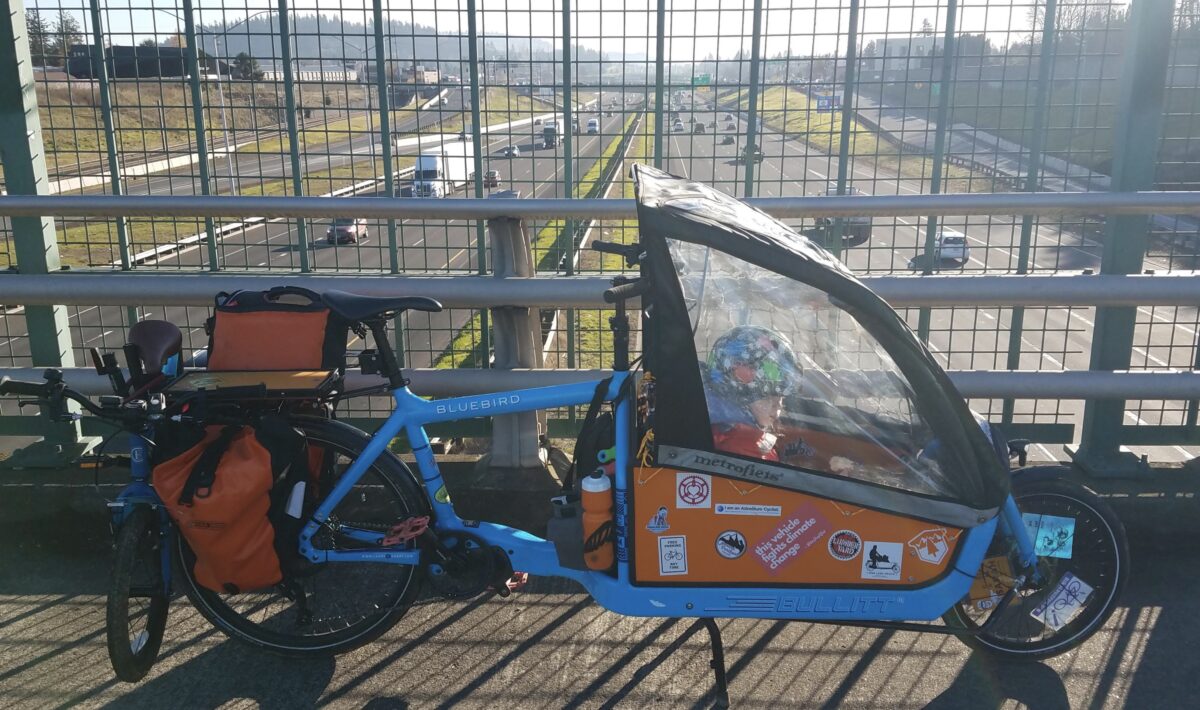
(Photos: Shawne Martinez)
Shawne Martinez is a southwest Portland stay-at-home-dad who puts his bikes to good use as a volunteer with Meals on Wheels, a yard sign deliverer for PBOT, and as a coordinator for the Pacific Northwest Search and Rescue (PNWSAR) Mountain Bike Team.
“I would have to be conservative with the pedal-assist if I wanted to make the trip on one charge.”
— Shawne Martinez
It was a foggy morning when we started off at 10:00 am. Our destination: Gateway Green Bike Park.
From where we live near the Multnomah/Washington county line in North Tigard/Southwest Portland it would be a 40-mile round trip to east Portland with 2,200-feet of elevation gain. I knew this would be a stretch for the battery on our electric-assist cargo bike. The cold weather, weight of a 5-year-old (and her bike) and the steep grades of the southwest hills would test our battery capacity. I would have to be conservative with the pedal-assist if I wanted to make the trip on one charge.
For months I’ve been seeking out public power outlets for charging opportunities. I’ve had a bit of “range anxiety” on long trips, concerned that we may run out to battery power and get stuck having to push the bike uphill. Surprisingly many outdoor outlets I find do not have power. (I carry a 110vac outlet tester with me.) Some outlets are locked, others have a keyed switch. I didn’t know of any public power outlets near Gateway Green, so we’d be hoping for the best mileage possible.
Advertisement
The Shimano control panel on my Bullitt cargo bike showed a starting range of 93 miles in “Eco” mode. As you use higher levels of pedal assistance, your range decreases. Some of the climbs on the way ‘down’ to the Willamette require using the highest level for me and the load. I constantly have to remember to switch back to Eco or the “Off” mode after a steep hill to conserve power.
We made it to Gateway Green with about 50% battery remaining. That might sound good, but most of the climbing is on our way home. I also had to keep in mind that I tend to use more e-assist towards the end of a long ride.
After the kid did 20-30 laps on the new pump track, (the new park is amazing) it was time to head back. I barely used the assist all the way to Sellwood knowing that the battery was getting low. I was definitely getting a workout! Everything was looking good until we hit “The Wall”. The climb from the Willamette River up to Barbur Blvd is a real battery-eater. I’ve done it on a regular (non-assist) cargo bike with the same load and barely made it. I went from being optimistic about getting home without stopping to being concerned as I watched the range drop quickly.
“We weren’t going to make it home. I made the executive decision to flip a u-turn.”

30 miles left. Then 20, 10. We passed Burlingame Fred Meyer to start the climb to Multnomah Village and the battery range dropped to just a few precious miles. We weren’t going to make it home. I made the executive decision to flip a u-turn and coast back to the grocery store.
A previous public power outlet search had revealed a live strip of outlets at the electric shopping cart charging area near the front door of Fred Meyer. We locked up at the bike rack, removed the battery from the bike and headed in.
We plugged in and started charging. Slipping inside the second set of doors I grabbed the first thing I saw: a bag of tangerines. With one eye on our battery we hit self checkout and “paid” for our few cents of electricity. 15 minutes of charging seemed like a good amount. I pulled the plug and reinstalled the battery on the bike.
Advertisement
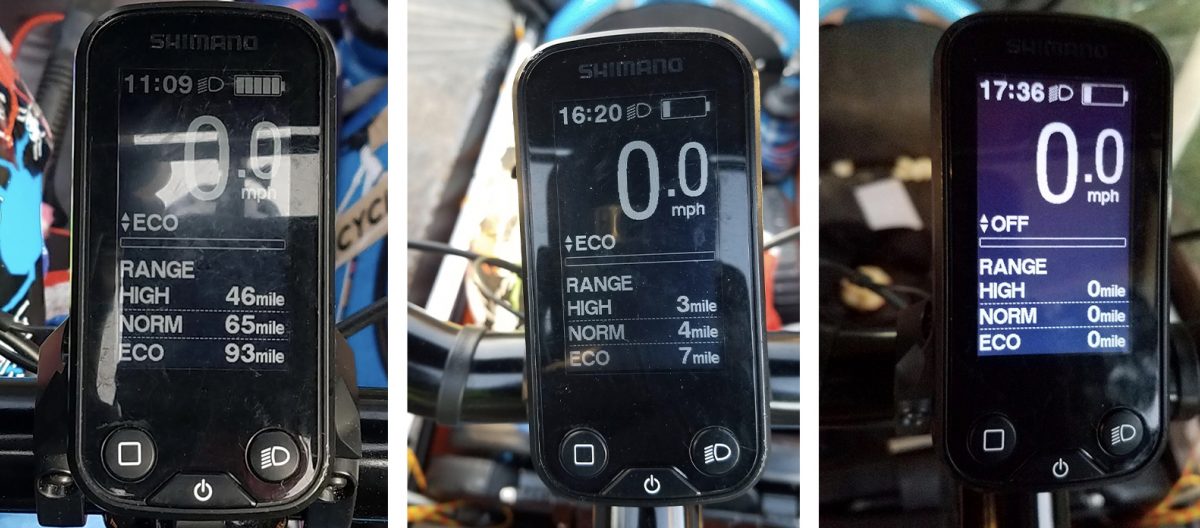
Now the display showed 8 miles of range. Would it be enough? Not only did we have the uphill to Multnomah Village, but then the climb to Capitol Highway at Taylors Ferry and a couple more hills after that (southwest!). Off we rolled with fresh tangerine on our lips, hoping for the best.
Morale soon shifted as range inevitably dropped again. 7. 6. 5. Would we have to make another stop? The power outlets at the Spring Garden Park picnic shelter are padlocked (why is that?). Could I get us home on muscle power? Range 4 miles, now 3. It held at 3 for a long time — not sure if that was a computer glitch or a helping hand from the bike gods — but up we went over Capitol Highway’s muddy shoulders and onto the narrow trail on Taylors Ferry Road.
2 miles, 1 mile, 0.
The motor kept pushing us over the last hill near Dickinson Park even with zero showing on the range. We coasted the rest of the way home just as the sun set. Test complete. Mission accomplished. 39 miles, 5 hours and 20 minutes of riding, one battery.
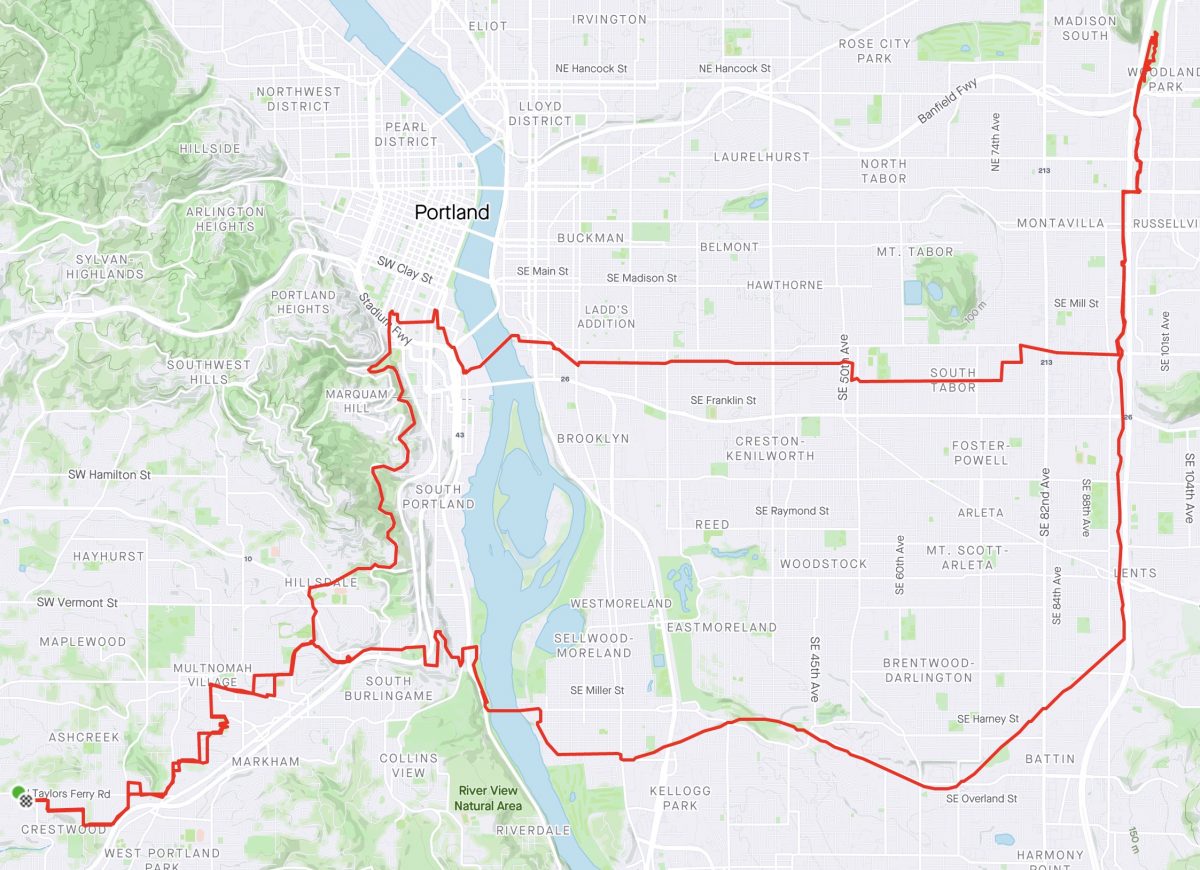
This ride was a test of our particular bike setup with the load we usually have. I discovered that a single charge (or single battery) is not enough to get us to Gateway Green and back. E-bike charging infrastructure would help tremendously. I could also get a second battery (but those can be expensive). Maybe we could get some of those outside outlets unlocked to let folks charge their devices and their transportation? A few cents of electricity can take you a long way on a bicycle.
For more on bike charging infrastructure at Gateway Green and other public spaces, see this post in the BikePortland Forums.
— Shawne Martinez, @RescueEwe on Twitter.
— Get our headlines delivered to your inbox.
— Support this independent community media outlet with a one-time contribution or monthly subscription.


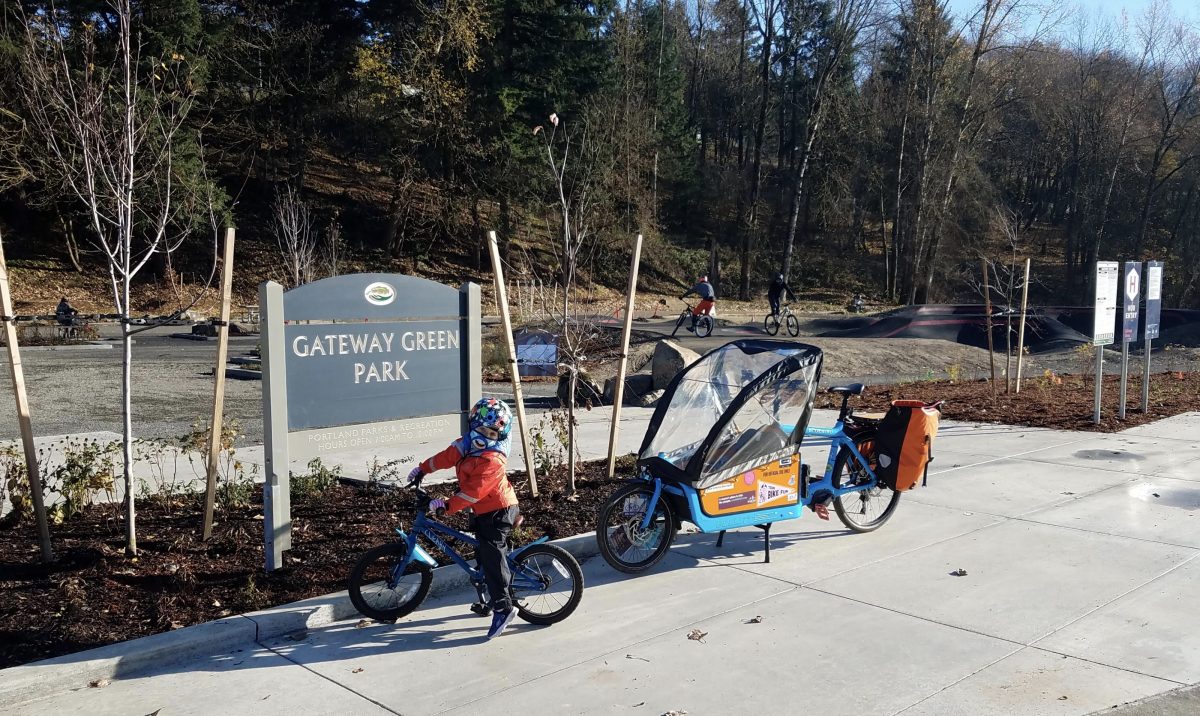

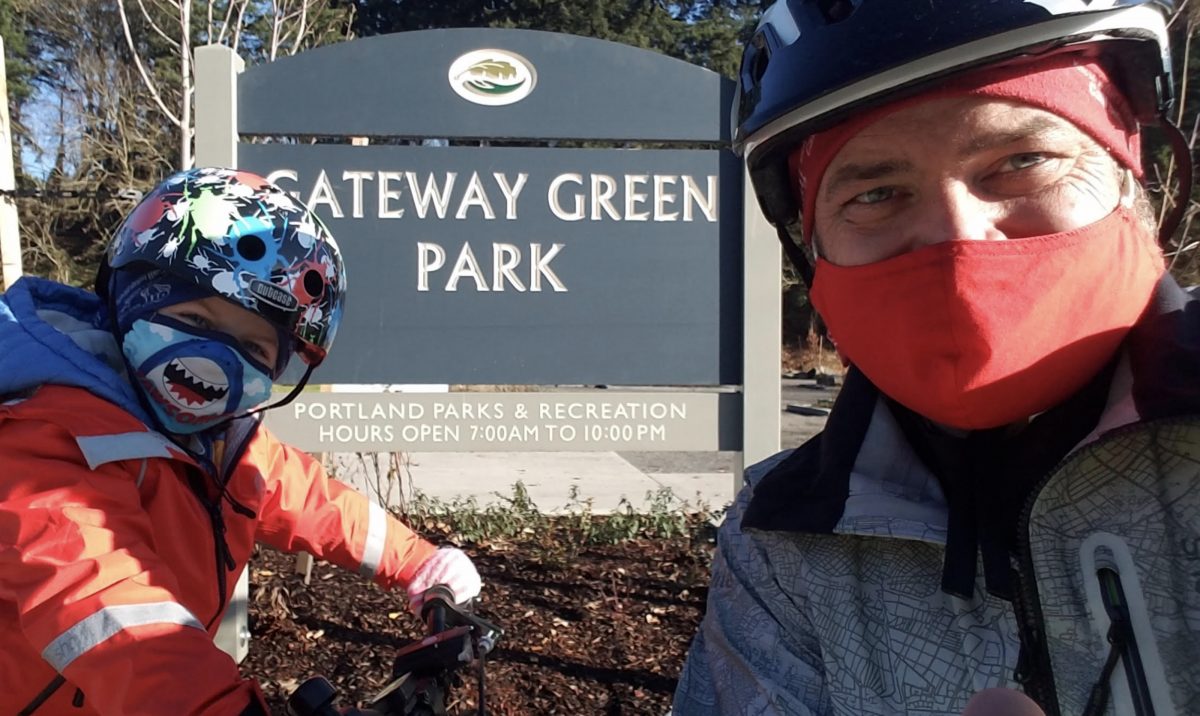

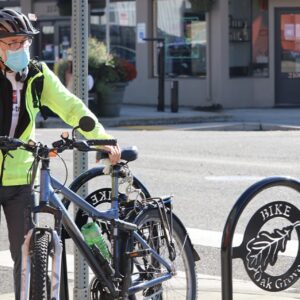


Thanks for reading.
BikePortland has served this community with independent community journalism since 2005. We rely on subscriptions from readers like you to survive. Your financial support is vital in keeping this valuable resource alive and well.
Please subscribe today to strengthen and expand our work.
Great story. Nothing like sweating the mileage while battery power drops.
We have a bullitt converted with a Bafang BBSHD and a single 14.5 AH 48V battery and get just over 50 miles on easiest mode on a flatish ride. Seems about the same as your experience. Keep at it.
Have you noticed a drop in battery capacity with the colder temps?
Nice work! Did you take the bullitt on the pump track?! Of course it would be great if you could just lock the bike up and ride the max north, but no one’s going to chance it with that rig. Do any of the EV charging stations offer a metered 110v outlet, or adapter & lower-power charge mode?
I think the lack of secure parking at MAX stations is the real answer to this particular problem. If you could leave the cargo bike at Beaverton, you could ride MAX to Gateway and access the park from there.
The variable cost of the power consumed to charge e-bikes would not be worth the cost of instrumentation. It’s not about the kWh consumption, but having a live 120v outlets 24/7 attracting unwanted loitering and unreasonable conducts to the areas, such as people charging their burner phone to hawk stolen items on OfferUp on department store WiFi, charging their Sawzall, parking their RV right up against it and running space heaters. That sort of thing.
They say that cover charge is used to weed out trouble makers. A reasonable per-use fee, like “customer use only” turns out to be a fairly effective deterrent.
Right… so if you can pay to use an EV station for a car, it would be cool if the same pay-to-use station had an outlet to charge a bike/whatever. Not too far of a stretch for that to be added. Paying for use would discourage abuse. Seems simple to me.
I didn’t ride on the track but was tempted with that rubberized surface! I’ve only seen one EV charging station with 110 outlets. That’s at OMSI under the solar panel array in the parking lot.
That was an enjoyable read. Thanks for sharing it.
Gabriel Park would be a fantastic spot for something similar to Gateway Green. Has the City expressed any interest in adding additional pump tracks around town? Other spots I can think of:
– Chimney Park
– Glendover
– Adding pump track to Powell Butte
Gabriel would be perfect but the neighbors around Gabriel are probably about as interested in additional people using “their” park as the Riverview neighbors were. I used to ride on the trails at Marshall, Maricara, and Riverview areas as a way to mix up the riding and avoid cars and pavement. Now all those areas are plastered with “no bikes” signs and I don’t ride them. The sad thing is that almost nobody uses those parks so it is not a issue with “conflicts” between users, it is just locals wanting a private park and Portland Park’s no bikes on turf general rule. Funny side note: Gabriel hosted cyclocross races back in the late 1980’s and early 1990’s.
PB is a nature park so probably not much of a possibility there. How about an upgrade to the Ventura Park pumptrack? The RC crowd could then take over and maintain the dirt pumptrack.
I raced cyclocross for the very first time in Gabriel Park. This was probably 1991 or 1992! I’d forgotten all about it until now!
I know that climb very well. It is a good justification for an e-bike, as climbing that hill every day on an a-bike would be challenging. So, I know that sinking feeling of seeing the range meter drop quickly.
I have found that bike manufacturer range estimates are obscenely optimistic. Although, Bosch has a very accurate range calculator. So, while you may not have or be looking at getting a Bosch system, this will give you a very clear idea of what factors will limit your range.
There is zero “justification” in regards to hills. Nothing more humorous than a battery running out. Damn funny, thanks!
Have you ever carried 100lbs of children (active load) on a bike?
Sure, if you’re dressed like a lycra sausage and you’re out for a weight weenie spin, hills are a lark.
However, a daily commute, 52 weeks a year, in all weather, with two panniers, 20 miles round trip, tell me you’d ride an a-bike over an 800′ hill twice a day and not resort to driving a car at least once.
This is exactly why I purchased my class 1 ebike. For me it is a 25 mile trip with significant climbing each way between the westside and downtown. I went from one bike commute per week to nearly 100%. A complete game changer in time savings vs no ebike (and same time as driving) and my own physical energy not being completely depleted.
Thanks for chipping in.
Dad of the year award!
“The power outlets at the Spring Garden Park picnic shelter are padlocked (why is that?).” I can see why someone living in affluent and safe Southwest Hill wonder this. Many fast food restaurants have removed complementary phone charging outlets for customers from counter and lounge seats in many parts of Portland excluding exceptionally affluent areas, like yours. Perks that attract good customers and draw good customers in affluent suburbs with effective and no non-sense police departments The cart charging outlets have been converted to non-standard outlets in Interstate/Lombard Fred Meyer most likely due to loitering issues attributed to non-customers.
In Lake Oswego, having outlets and fast WiFi at one quick serve may win desirable customers from competitors. If non-sense occurs, police are called immediately and they take care of it. In Portland, such amenities attract people whose usage pattern are contradictory to the expected dollars spent per seat minutes and some of them may behave in manners that generate complaints from other paying customers.
FYI, if you think college students are affluent, you are missing the point. Certainly college students are privileged to be receiving an education, but they are not affluent. Many students graduate college with overwhelming debt. The antithesis of affluence. I don’t know what the population per capita of the SW Hills is students. I know there are a lot of them in Multnomah Village and Hillsdale. You’re confusing the Skyline part of SW hills with this area, which is not affluent.
Also, it’s not Lake Oswego.
The owner-occupants in many SWNI neighborhoods are extremely NIMBY and tend to be vocal and politically involved and as such they tend to get less of the non-sense.
“The temporary use of the Sears Armory as a homeless shelter was discussed at
length. The MNA recognizes that all citizens are concerned about people
who are homeless/houseless.” in reference to Sears Armory when it was a temporary homeless shelter. Oh boy did the members of Multnomah Village go ballistic over that thing.
From the February 2016 meeting minutes of the privileged Collins View neighborhood (CVNA) “Get the license plate of a car doing something stupid. If they live in or around the neighborhood, Officer Casper will knock on the door and discuss the issue with them.” we could only dream of getting that sort of thing being done with drivers who misbehave around cyclists. This kind of VIP treatment is called class privilege.
Many, but not all.
So far Washington County has the most public power outlets that I’ve found. All of the Cook Park picnic shelters have multiple outlets. Both Tigard and Beaverton libraries offer power. I’m still looking and will update.
It would be cool if Gateway Green had some bike lockers to lock up your e-bike and charge it securely but based on the response when we tried to get access to power from the city for bike polo I doubt it is in the cards.
Years ago, there were power outlets at the MAX stops underneath the transit map boards. But those days are gone
https://www.oregonlive.com/commuting/2013/10/trimet_covers_not-so-hidden_po.html
“Also, Altstadt said, it’s against TriMet Code to use platforms for non-transit use. “We were seeing people come on platforms just to use the outlets.””
It’s the last sentence that pretty much sums up what led to its demise. Fare paying customers who kept things under watch was probably not their greatest concerns, but it was probably “unwanted persons” activity (people who were on platform that do not involve legitimate fare paying transit usage on that occasion)
It seems power hungry smart phones back then had people looking to recharge them all the time. Perhaps before these were the norm, there wasn’t much use to look for a place to charge gadgets? I remember observing riders on the Max reading books…then a few years later kindles….then eventually smartphones.
Availability of WiFi in public places that do not require formal registration drives public nuisance behaviors. Make getting cell phones more difficult and similar to getting a bank account. It would partly resolve vagrancy related electricity theft issues.
Your route? You went north on the west side of the river? Seems that would have required a lot more uphill than going via Springwater there & back. ? IDK not having really ridden the west side much, but I still know that’s a lot of UP, while the SC route is only moderate UP.
RE the “spare” battery “better to have & not need, than need & not have.”
I would take Multnomah Blvd to Terwilliger then Barbur if I’m riding solo but won’t take the kid on the Freeway ramps. I often find the safer route is longer and steeper, unfortunately.
You can always charge up at Go By Bike at the bottom of the aerial tram! Mon-fri 6am to 7:30pm. You can even drop your bike off in the secure valet area and explore south waterfront. We also have free charging for lights and cell phones too.
Awesome! Thank you so much!
Great story but what if you just pedaled your bike? Guess there wouldn’t be a story.